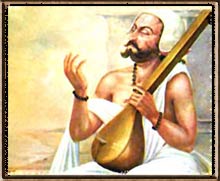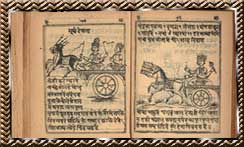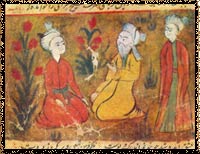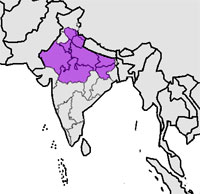Hindi Language

 Introduction
IntroductionHindi is an Indo-Aryan language and about 487 million people speak the language. In India, it is the main language used in the northern states of Rajasthan, Delhi, Haryana,Uttarakhand, Uttar Pradesh, Madhya Pradesh, Chhattisgarh, Himachal Pradesh, Jharkhand and Bihar, and is spoken in much of north and central India along with other languages such as Punjabi, Gujarati, Marathi or Bengali. In other parts as well, like Nepal, Bangladesh and Pakistan, people are able to understand Hindi.Hindi is supposed to be derived from the Khari Boli dialect, which is also known as Hindustani.
Hindi language has its roots in the classical Sanskrit language and contains more vocabulary from Sanskrit. Hindi, with English and most other European languages, was evolved from a language thought to have been spoken in Central Asia around 5,000 BC, which is being called the Indo-European parent language by linguists. Due to this reason and because of the 200-year British rule in India, many basic words in Hindi are found to be the same as or similar to their English equivalent.
 Only during the 4th century AD, Hindi was started to be used in writing. It was originally written with the Brahmi script, but since the 11th century AD, it has been written with the Devanagari alphabet, which is common to several other Indian languages as well. The first printed book in Hindi was John Gilchrist's Grammar of the Hindoostanee Language. Much of the vocabulary of Hindi is from Sanskrit, though Hindi resembles, in many aspects, the Urdu language. Their grammar and much of their vocabulary are virtually identical. But for the difference that Hindi is written in Devanagari and draws vocabulary from Sanskrit, while Urdu is written in Persian script and draws vocabulary from Persian and Arabic, these two languages are very much similar and this similarity led to the presumption by linguists that before the partition of India into India and Pakistan, spoken Hindi and Urdu were the same language, known as Hindustani.
Only during the 4th century AD, Hindi was started to be used in writing. It was originally written with the Brahmi script, but since the 11th century AD, it has been written with the Devanagari alphabet, which is common to several other Indian languages as well. The first printed book in Hindi was John Gilchrist's Grammar of the Hindoostanee Language. Much of the vocabulary of Hindi is from Sanskrit, though Hindi resembles, in many aspects, the Urdu language. Their grammar and much of their vocabulary are virtually identical. But for the difference that Hindi is written in Devanagari and draws vocabulary from Sanskrit, while Urdu is written in Persian script and draws vocabulary from Persian and Arabic, these two languages are very much similar and this similarity led to the presumption by linguists that before the partition of India into India and Pakistan, spoken Hindi and Urdu were the same language, known as Hindustani. Hindi became the official language of India on the 26th January, 1965, although English and 21 other languages are also recognized as official languages by the Constitution of India. Article 343(1) of the Constitution provides that Hindi in Devanagari script shall be the Official Language of the Union. Article 343(2) also provided for continuing the use of English in official work of the Union for a period of 15 years (i.e., up to 25 January 1965) from the date of commencement of the Constitution. Article 343(3) empowered the Parliament to provide by law for continued use of English for official purposes even after 25 January, 1965.
 Literature
Literature The age of the Vedas is considered as the beginning of Indian literature. Rig, Yajur, Sama, and Atharvaveda and the two epics Ramayana and Mahabharata are the celebrated literary and philosophical treasures of India. Many a linguist think that Hindi was written in Devanagari and drew its vocabulary from Sanskrit. As such Hindi literature may also be construed as having its origin from the Vedic ages. Literature is a term most commonly used to refer to works of creative imagination, including those of poetry, drama, fiction, and nonfiction. Literature is an interesting tool to understand the culture and tradition of different ages. Apart from this it carries a creative quality that supplies a sense of fulfillment to the mind. Basically, Hindi literature is divided into four stages viz., Adikal, Bhaktikal, Ritikal and Adhunikkal.
Literature in the Adikal (the Early Period):
 Between the middle of the 10th century and the beginning of the 14th century, known as Adhikal, Hindi literature was mainly in the form of poetry. Religious ideologies or the bravery of the great rulers and warriors were the focus of these works. The earliest version is called by the name Apabhramsha poetry. The renowned poet Gorakhnath and his followers had a great influence on other mystic poets like Kabir, Nanak and Dadu Dayal. During this period Jain poets like Swayambhu, Som Datt Suri, Sharang Dhar and Nalla Singh composed the Charit Kavyas, which comprised of moral tenets and portrayals of
nature. However, heroic poetry was an integral part of the Hindi literature of the Adikal period. Several raso-kavyas like Prithiviraj Raso, Visaldev Raso, Parmal raso, etc. came into being during this period.
Between the middle of the 10th century and the beginning of the 14th century, known as Adhikal, Hindi literature was mainly in the form of poetry. Religious ideologies or the bravery of the great rulers and warriors were the focus of these works. The earliest version is called by the name Apabhramsha poetry. The renowned poet Gorakhnath and his followers had a great influence on other mystic poets like Kabir, Nanak and Dadu Dayal. During this period Jain poets like Swayambhu, Som Datt Suri, Sharang Dhar and Nalla Singh composed the Charit Kavyas, which comprised of moral tenets and portrayals of
nature. However, heroic poetry was an integral part of the Hindi literature of the Adikal period. Several raso-kavyas like Prithiviraj Raso, Visaldev Raso, Parmal raso, etc. came into being during this period. Literature in Bhakti Kal (the Devotional Period):
The period between the 14th and the 17th century is known as the Bhakti Kal. Emergence of devotional poetry is the highlight of this period. Kabir was the most important poet of the period 1399 to 1518 AD. He along with the poets Guru Nanak, Dharma Das, Maluk Das, Dadudayal, Sunder Das laid an emphasis on the importance of knowledge for the realization of God. The Sufi poets, on the other hand, preached love as the means to realise God. Jayasi, Manjhan, Kutuban and Usman were the pioneers of this school. Tulsi Dass, Agradasa, Nabhadasa and Pran Chand Chauhan were other important poets of this group. Surdas (1483-1563) Sur Sagar and Sur Saravali are the masterpieces of devotional Hindi poetry. Nand Das, Parmananda Das and Meera Bai were other celebrated poets of the medieval times. Maulana Daud, Kutuban, Malik Mohammad Jayasi were some famous Sufi poets of this period. The devotional period created immortal literature and is distinguished as the golden age of Hindi Poetry.
Literature in Ritikal (the Scholastic period):
The period between1600-1850 AD is known as Ritikal. Hindi literary works created during this period resembled more like Sanskrit poems in as much as the rhetoric tradition it followed. Different aspects of poetics such as rasa, alankara and nayika bheda were well managed. Leading poets like Chintamani Tripathi, Keshavadasa, Mati Ram, Deva, Kulpati Misra, and Bhikari Das followed the Rithibadha tradition and composed on definitional and illustrative themes. The Ritimukta group of poets, on the other hand have done a tremendous work highlighting the meaning and power of love and few of such renowned poets of this tradition are Ghanananda, Bodha and Thakur.
Literature in Adhunikaal (the Modern Period):
Middle of the 19th century onwards is called Adhunikaal in Hindi literary world. An early dialect of Hindi known as Khariboli was evolved during the initial time of this period. And many a literary creation were made in Khariboli prose. Adhunikaal is divided into four phases: the age of Bharatendu or the Renaissance (1868-1893), Dwivedi Yug (1893-1918), Chhayavada Yug (1918-1937) and the Contemporary Period (1937 onwards).
 Mahavir Prasad Dwivedi is regarded as the architect of modern Hindi prose He introduced a refined style of writing in Hindi prose,. During this phase, social, political and economic problems were portrayed through the medium of poetry. Maithali Saran Gupta revived the tradition of epic poetry with his long narrative poems apart from translating Meghnadvadh kavya into Hindi. Other important writers of this period are Nathuram Sharma Shankar, Ayodhya
Sinha Upadhyay, Ram Naresh Tripathi and Gopala Sarana Sinha.In the 1920's a new aesthetic and subjective style of poetry were composed which broke the traditional convension. Makhanlal Chaturvedi, Balkrishna Shama "Navin", Siyaram Sharan Gupta, Jayashankar Prasad, Surya Kant Tripathi, Sumitranandan Pant, Mahadevi Verma and
Subhadrakumari Chauhan were the leading poets of this tradition.
Mahavir Prasad Dwivedi is regarded as the architect of modern Hindi prose He introduced a refined style of writing in Hindi prose,. During this phase, social, political and economic problems were portrayed through the medium of poetry. Maithali Saran Gupta revived the tradition of epic poetry with his long narrative poems apart from translating Meghnadvadh kavya into Hindi. Other important writers of this period are Nathuram Sharma Shankar, Ayodhya
Sinha Upadhyay, Ram Naresh Tripathi and Gopala Sarana Sinha.In the 1920's a new aesthetic and subjective style of poetry were composed which broke the traditional convension. Makhanlal Chaturvedi, Balkrishna Shama "Navin", Siyaram Sharan Gupta, Jayashankar Prasad, Surya Kant Tripathi, Sumitranandan Pant, Mahadevi Verma and
Subhadrakumari Chauhan were the leading poets of this tradition.
 The writings of Balakrishna Sharma Navin, Bhagvati Charan Varma, Ramdhari Singh Dinkar, Rameshwar Shukla and Narendra Sharma are considered as examples of Progressive movement. Harivansh Rai Bachchan's style is known as the poetry of passion. Then followed an experimental movement called Prayogavada, which came to
be known in later times as the 'Nai Kavita'. The movement reflected modern insight and S.H.Vatsyayan 'Ajneya', Shivmangal Singh 'Suman' , Girija Kumar Mathur , Gajananmadhav Muktibodh , Dharamvir Bharati , Nirmal Verma and others are the pioneers of this trend. The development of Hindi prose dates back to 1868.
The writings of Balakrishna Sharma Navin, Bhagvati Charan Varma, Ramdhari Singh Dinkar, Rameshwar Shukla and Narendra Sharma are considered as examples of Progressive movement. Harivansh Rai Bachchan's style is known as the poetry of passion. Then followed an experimental movement called Prayogavada, which came to
be known in later times as the 'Nai Kavita'. The movement reflected modern insight and S.H.Vatsyayan 'Ajneya', Shivmangal Singh 'Suman' , Girija Kumar Mathur , Gajananmadhav Muktibodh , Dharamvir Bharati , Nirmal Verma and others are the pioneers of this trend. The development of Hindi prose dates back to 1868.The prose literature also found a huge craving and the writers have shown their flair for drama, novel, short story, play, fiction, essay and also criticism. So many eminent personalities have made an unimaginable contribution to these kinds of Hindi literature. Bharatendu Harishchandra, Radha Krishna Das, Devaki Nandan Khatri, Mahavir Prasad Dwivedi, Padma Singh Sharma Jayshankar Prasad, Rai Krishna Das, Phanishwar Nath Renu, Yash Pal, Jagdamba Prasad Dikshit, Rahi Masoom Raza, Jagdish Chandra Mathur and Lakshminarayan Lal are a few to mention.


